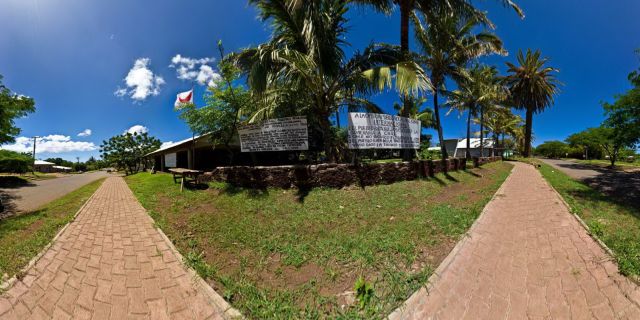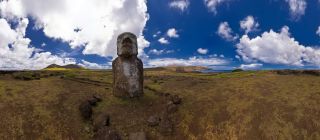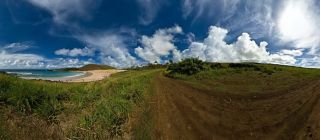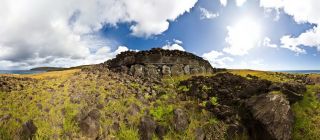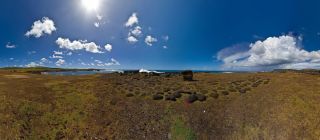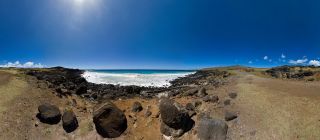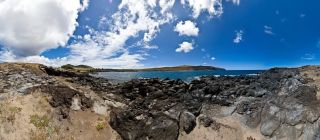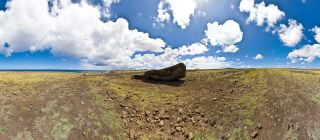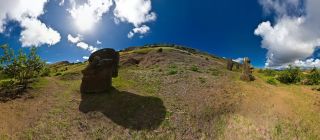
Rano Raraku (External Slope 07 of 13) : Moai in progress !
Resolution : 67 Mpixels
Date taken : 2009-02-24

Another Day At Ahu Tongariki (Wiew from Front Right)
Resolution : 67 Mpixels
Date taken : 2009-02-25

Rano Raraku
Rano Raraku is a volcanic crater formed of consolidated volcanic ash, or tuff, and located on the lower slopes of Tereva...

Rano Kau Volcano (From Top)
Volcano Rano Kau emerged after hundreds of thousands of years, followed by volcano Maunga Terevaka, which created the is...
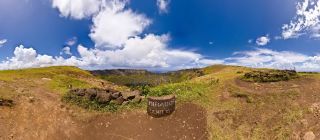
Rano Kau Volcano (Up the Mirador !)
Volcano Rano Kau emerged after hundreds of thousands of years, followed by volcano Maunga Terevaka, which created the is...

Ahu Tongariki Moai (Front Left)
This is Ahu Tongariki, the largest Ahu on Rapa Nui. Its Moai were toppled during the island's civil wars and in the twen...

Ahu Tongariki (Middle Front)
This is Ahu Tongariki, the largest Ahu on Rapa Nui. Its Moai were toppled during the island's civil wars and in the twen...

Ahu Tongariki (Front Right)
This is Ahu Tongariki, the largest Ahu on Rapa Nui. Its Moai were toppled during the island's civil wars and in the twen...

Ahu Tongariki (Fallen Moai)
This is Ahu Tongariki, the largest Ahu on Rapa Nui. Its Moai were toppled during the island's civil wars and in the twen...
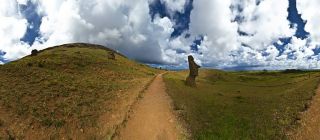
Rano Raraku Path
Rano Raraku is a volcanic crater formed of consolidated volcanic ash, or tuff, and located on the lower slopes of Tereva...

Rano Raraku Hdr under the rain !
Rano Raraku is a volcanic crater formed of consolidated volcanic ash, or tuff, and located on the lower slopes of Tereva...

Rano Raraku (External Slope 01 of 13)
Rano Raraku is a volcanic crater formed of consolidated volcanic ash, or tuff, and located on the lower slopes of Tereva...

Rano Raraku (External Slope 02 of 13)
Rano Raraku is a volcanic crater formed of consolidated volcanic ash, or tuff, and located on the lower slopes of Tereva...

Rano Raraku (External Slope 03 of 13)
Rano Raraku is a volcanic crater formed of consolidated volcanic ash, or tuff, and located on the lower slopes of Tereva...

Rano Raraku (External Slope 05 of 13)
Rano Raraku is a volcanic crater formed of consolidated volcanic ash, or tuff, and located on the lower slopes of Tereva...

Rano Raraku (External Slope 06 of 13)
At the horizon far away, you can see Ahu Tongariki Rano Raraku is a volcanic crater formed of consolidated volcanic ash,...

Rano Raraku (External Slope 07 of 13) : Moai in progress !
This is an unfinished Moai...Enjoy the work in progress... Rano Raraku is a volcanic crater formed of consolidated volca...
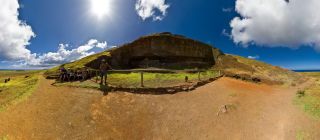
043 Rano Raraku (External Slope 08 of 13)
Here is Nano at work... Nano is a native Rapa Nui Guide working for Discover Rapa Nui ... Rano Raraku is a volcanic crat...

Rano Raraku (External Slope 09 of 13)
Rano Raraku is a volcanic crater formed of consolidated volcanic ash, or tuff, and located on the lower slopes of Tereva...
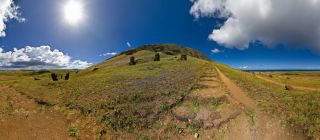
Rano Raraku (External Slope 10 of 13)
Rano Raraku is a volcanic crater formed of consolidated volcanic ash, or tuff, and located on the lower slopes of Tereva...

Rano Raraku (External Slope 11 of 13)
Rano Raraku is a volcanic crater formed of consolidated volcanic ash, or tuff, and located on the lower slopes of Tereva...
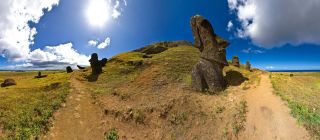
Rano Raraku (External Slope 12 of 13)
Rano Raraku is a volcanic crater formed of consolidated volcanic ash, or tuff, and located on the lower slopes of Tereva...
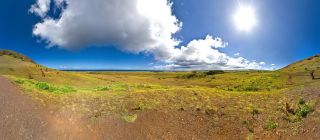
Rano Raraku (External Slope 13 of 13)
Rano Raraku is a volcanic crater formed of consolidated volcanic ash, or tuff, and located on the lower slopes of Tereva...

Ahu Vinapu Ceremonial Center
The ceremonial center of Ahu Vinapu includes one of the larger ahu on Rapa Nui.

Ahu Vinapu
Ahu Vinapu, Rapa Nui . The ceremonial center of Vinapu includes one of the larger ahu on Rapa Nui.

Sunrise on Ahu Vinapu
Ahu Vinapu is archaeological site on Rapa Nui in Chilean Polynesia. The ceremonial center of Vinapu includes one of the...
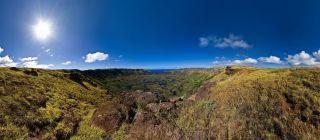
(Nearly) Inside Rano Kau Volcano
Rano Kau is a 324 m (1,063 ft) tall extinct volcano that forms the southwestern headland of Easter Island... В

Orongo Village, main entrance
(lot of stuff to read directly on the pano) Orongo is a stone village and ceremonial center at the southwestern tip of R...

Orongo Village Again
Orongo is a stone village and ceremonial center at the southwestern tip of Rapa Nui. Until the mid-nineteenth century O...

Orongo PathWay
Orongo is a stone village and ceremonial center at the southwestern tip of Rapa Nui. Until the mid-nineteenth century O...

Orongo Pathway (SomeWhere else)
Orongo is a stone village and ceremonial center at the southwestern tip of Rapa Nui. Until the mid-nineteenth century O...

Orongo & The Motu
Orongo is a stone village and ceremonial center at the southwestern tip of Rapa Nui. Until the mid-nineteenth century O...

Anakena Moais (Front)
Anakena is a white coral sand beach in Rapa Nui National Park on Rapa Nui (Easter Island)

Anakena Beach (Far Away)
Anakena is a white coral sand beach in Rapa Nui National Park on Rapa Nui (Easter Island)

Anakena Beach : Moai Alone
Anakena is a white coral sand beach in Rapa Nui National Park on Rapa Nui (Easter Island)

Anakena (Back)
Anakena is a white coral sand beach in Rapa Nui National Park on Rapa Nui (Easter Island)

Anakena Beach (Cloudy Version)
Anakena is a white coral sand beach in Rapa Nui National Park on Rapa Nui (Easter Island)

Anakena Beach (Sunny Version)
Anakena is a white coral sand beach in Rapa Nui National Park on Rapa Nui (Easter Island)

Ahu Tongariki (So Far Away)
Ahu Tongariki is the largest Ahu on Easter Island. Its Moai were toppled during the island's civil wars and in the twent...

Another Day At Tongariki (View from back)
Ahu Tongariki is the largest Ahu on Rapa Nui/Easter Island. Its Moai were toppled during the island's civil wars and in ...

Another Day At Tongariki (Front Center)
Ahu Tongariki is the largest Ahu on Rapa Nui/Easter Island. Its Moai were toppled during the island's civil wars and in ...

Ahu Tongariki (Again)
Ahu Tongariki is the largest Ahu on Rapa Nui/Easter Island. Its Moai were toppled during the island's civil wars and in ...

Another Day At Ahu Tongariki (Wiew from Front Right)
Ahu Tongariki is the largest Ahu on Rapa Nui/Easter Island. Its Moai were toppled during the island's civil wars and in ...

Another Day At Tongariki (The Lonely Moai)
Ahu Tongariki is the largest Ahu on Rapa Nui/Easter Island. Its Moai were toppled during the island's civil wars and in ...

Ahu Akivi (Front Left)
Unlike other Rapa Nui ceremonial centers with ahu, the Akivi-Vaiteka Complex is not located on the coast. In contrast to...

Ahu Akivi (Front)
Unlike other Rapa Nui ceremonial centers with ahu, the Akivi-Vaiteka Complex is not located on the coast. In contrast to...

Ahu Akivi (Front Right)
Unlike other Rapa Nui ceremonial centers with ahu, the Akivi-Vaiteka Complex is not located on the coast. In contrast to...

Ahu Akivi (Back)
Unlike other Rapa Nui ceremonial centers with ahu, the Akivi-Vaiteka Complex is not located on the coast. In contrast to...

Tahai Hanga Kio E Ahu Ko Te Riku
The Tahai Ceremonial Complex is an archaeological site on Rapa Nui (Easter Island) in Chilean Polynesia. Restored in 197...

Tahai Hanga Kio E Ahu Tahai
The Tahai Ceremonial Complex is an archaeological site on Rapa Nui . Restored in 1974 by the late Dr. William Mulloy, an...
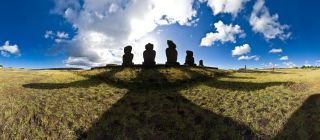
Tahai Hanga Kio E Ahu Vai Uri at Sunset
The Tahai Ceremonial Complex is an archaeological site on Rapa Nui (Easter Island). Tahai comprises three principal ahu ...

Tahai Hanga Kio E At Sunrise With Rapa Nui Women
The Tahai Ceremonial Complex is an archaeological site on Rapa Nui. Restored in 1974 by the late Dr. William Mulloy, an ...

Tahai At Sunrise : Ahu Ko Te Riku
The Tahai Ceremonial Complex is an archaeological site restored in 1974. Tahai comprises three principal ahu from north ...

Tahai In The Morning : Ahu Vai Uri
The Tahai Ceremonial Complex is an archaeological site on Rapa Nu. Tahai comprises three principal ahu from north to sou...

Tahai : In The Middle
The Tahai Ceremonial Complex is an archaeological site on Rapa Nui. Tahai comprises three principal ahu from north to so...

Ahu Tahai
The Tahai Ceremonial Complex is an archaeological site on Rapa Nu. Tahai comprises three principal ahu from north to sou...

Rano Raraku : On The Edge Of The Cratere
Search for the moai ! (they are almost everywhere !) Rano Raraku was the quarry that produced about 95% of the island's ...

Inside Rano Raraku : Approaching Moai Land
This was one of my best experience on Ister Island... Early in the morning, and alone inside this fabulous place, with h...

Inside Rano Raraku : The Moai Quarry
Don't forget to enjoy this fabulous place !! Rano Raraku was the quarry wich supplied the stone from which about 95% of ...

Inside Rano Raraku : The Top Of The Crater
If you look through the gap of the volcano, you can see Ahu Tongariki . Inside the volcano, there are moai everywhere......

Welcome To Rano Raraku
Please read more interesting things directly on the pano... Rano Raraku was a quarry for about 500 years until the early...

Haka Pei
This is the place where happen Haka Pei. Haka Pei is acompetition in the Tapati festival where two banana tree stumps ar...

Mataveri Runway
Since in the years 1970 NASA proceeded to the enlarging of the aerodrome of Mataveri, thus creating an emergency landing...
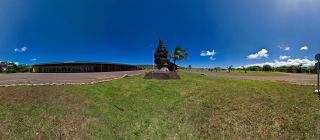
Mataveri Airport
Mataveri International Airport or Isla de Pascua Airport (IATA: IPC, ICAO: SCIP) is located at Hanga Roa on Rapa Nui (Ea...





















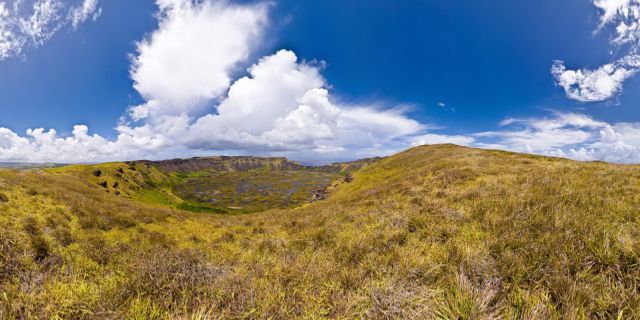











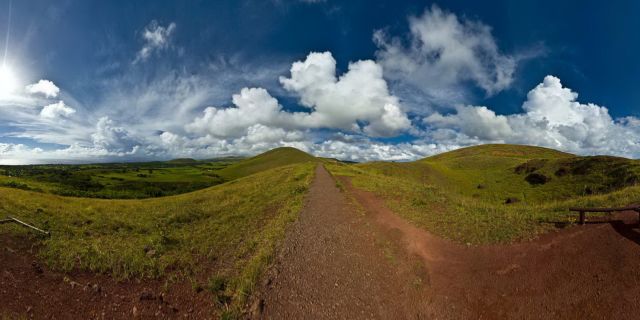




















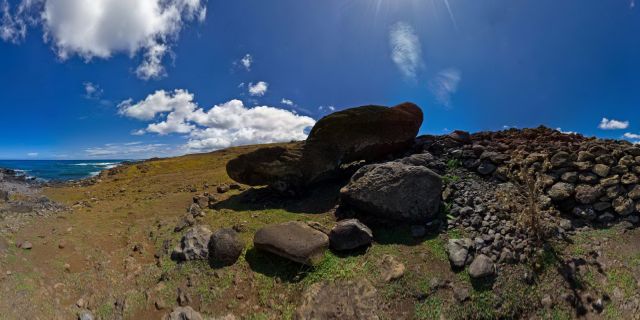


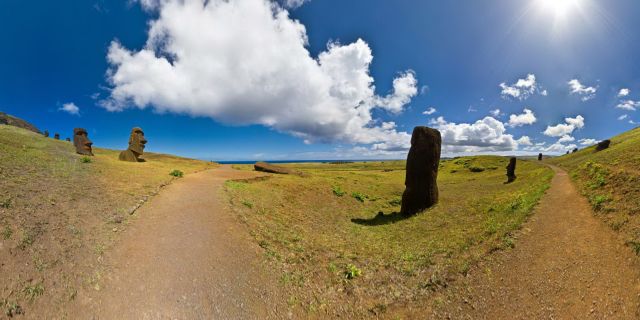





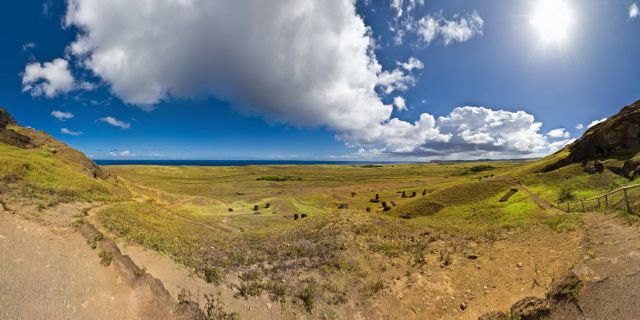












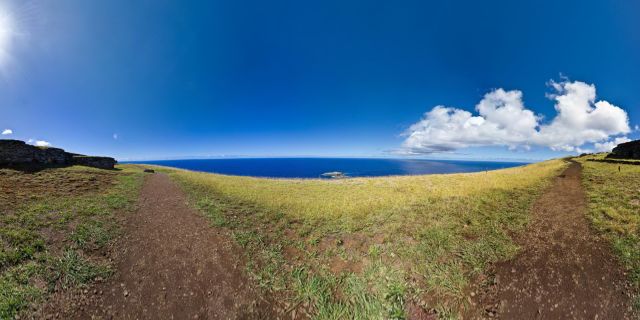

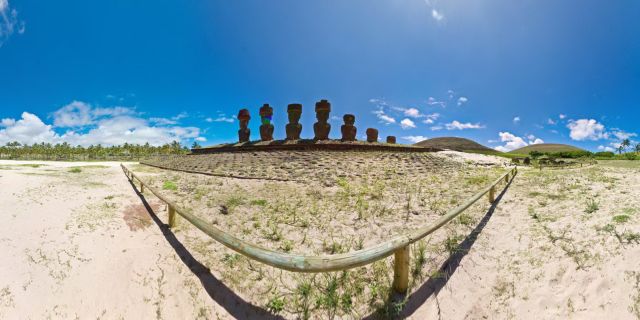





















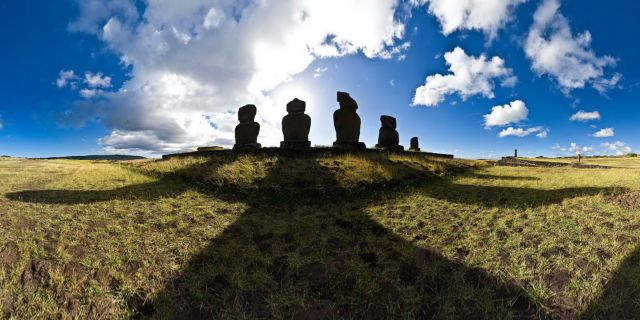




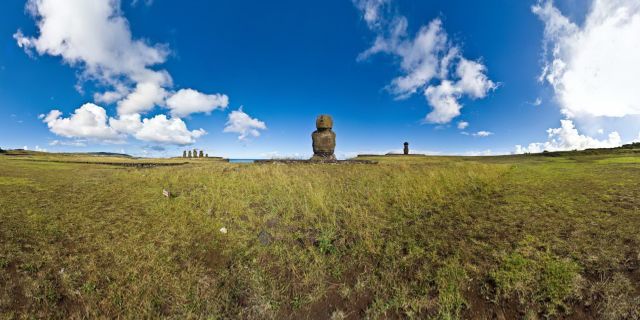


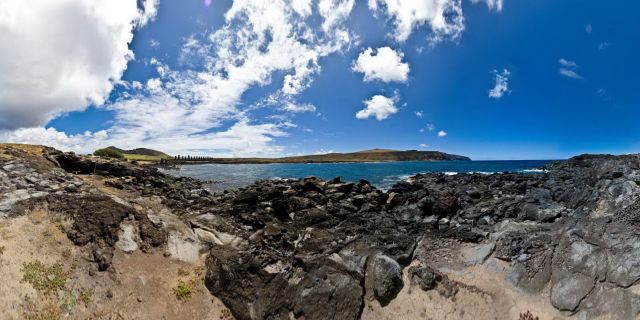





















![Since in the years 1970 NASA proceeded to the enlarging of the aerodrome of Mataveri, thus creating an emergency landing strip for the space shuttles, the large transport aircrafts can from now on land on this airport, more isolated from the world. This enlarging caused to increase the tourist frequentation of the island, which represents the first source of revenue today. The number of tourists remains however very limited compared to other tourist island. For reasons stated further below in this caption text, planes would approach and land exclusively from the northern end towards the southern end and lift off from the southern end towards the northern end. Also, this is the only runway whatsoever within about 4000km. This means that airplanes bound for the island have to carry sufficient fuel for twice that distance - in case that landing on the island proves impossible for any reason and the aircraft has to proceed to the nearest available airport. This would be Tahiti or the Chilean coast. Pitcairn, the nearest inhabited land to the west, has no airstrip, and the nearest airstrip to the west at [...] is too short for long-range commercial airplanes. The rest is Pacific Ocean. As you can nearly see, the runway is not only short (3318m today from originally less than 3000m), but also, you better make best use of its length, or you end up not at elevation 10m above sea level, but at 2000m below it. It is a steep drop beyond the shore. The Boeing 707 models operated by Lan Chile for the flight route from Santiago de Chile to Easter Island and then onwards to Papeete, Tahiti without fully refueling were custom-modified in order to extend their range so that they would be able to make the stretch. Easter Island has no proper jet refueling facility. When plans were made by the Chilean government to build one, worldwide protests in favor of the preservation of the natural state of the island eventually led to the plans being abandoned. So the 707s had a reduced passenger seating and cargo configuration and a supplemental full-height fuel tank installed in the aft section.so that they could land on Easter Island, lift off and continue on to Tahiti, where they would fully refuel for the first time after having left Santiago de Chile. The modified 707 was back then the only long-distance passenger aircraft which could take that trip. That machine is still in service and is now operated by the Chilean army for civilian supplies and government cargo flights to the island. A ship visited the island twice a year to bring regular supplies and fuel. Also take note that the runway, now 3318m long after being extended by NASA in 1984 in order to accomodate an emergency Space Shuttle landing, was shorter in the 1970s. Check Wikipedia and you will see that the earlier 707 models had a landing and takeoff run longer than the actual length of the runway at IPC. In order to make up for that, they made use of a special topological feature of the runway: The runway of Mataveri International Airport IPC is not horizontally level, but sloped by about five degrees. The 707s landing at IPC land uphill and take off downhill taking advantage of the gravitational acceleration and deceleration forces providing or reducing kinetic energy in order to make up for its insufficient length. Starting pilots would take their 707s all the way to the southern end of the runway, turn the plane around almost on the spot, apply the brakes, turn their engines up to maximum emergency power, wait until the landing gear almost started to skid, and then let go off the brakes. Similarly, landing pilots would slow down their planes close to minimum control speed, below the minimum specified approach and landing speed, and close to the lower tolerance limit for the aircraft, hit the runway within its first meters fairly hard and applied maximum possible braking and reverse thrust power to get the aircraft to stop before it ran out of runway.](/templates/yootheme/cache/115-633ab728.jpeg)

